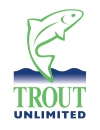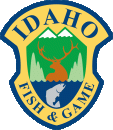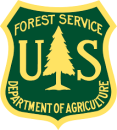Location
States
IdahoEcosystem
River/streamIntroduction
Bull trout (Salvelinus confluentus), a cold-water fish native to the Pacific Northwest, were once widely distributed across their range but are now classified as threatened under the Endangered Species Act (ESA). This species requires clean water with water temperatures below 15°C (59°F). When suitable habitat is available, bull trout will exhibit two general behaviors: (1) reside within a small isolated area through the year (resident form) or (2) migrate large distances between seasons in order to find optimal spawning, forage or winter habitat (migratory form). Arrowrock Dam and Reservoir, located on the Boise River in Idaho, supports winter habitat for migratory bull trout. The reservoir, managed by the Bureau of Reclamation (Reclamation) for water storage, flood control and recreation, is highly regulated and water management has restricted bull trout movement and altered habitat.
Reservoirs often provide important habitat for federally protected species like bull trout, but it can be difficult for biologists to identify which habitat parameters are most important to an individual species and how reservoir operations affect those parameters. Reclamation is often required through the ESA to perform field studies or annual monitoring to determine impacts of reservoir operations on protected fish and the habitat they require (critical habitat); the Boise River is one of those areas where such studies are necessary. The Boise River is a highly regulated system and managed for multiple uses, leaving limited opportunities to use operational flexibility to meet environmental requirements. In this project, Reclamation fish biologists sought to understand the specific habitat parameters related to the depth and water temperature preferences of bull trout that use Arrowrock Reservoir. Once identified, these relationships allow water managers to explore operational flexibilities to maximize benefits for this species.
Reclamation biologists surgically attached radio telemetry tags to bull trout and tracked movement patterns and habitat use of tagged fish between March and November from 2012 to 2014. These data were used to identify timeframes when environmental conditions approached or exceeded critical thresholds for the species. Combining these data with other available analyses including: water quality, habitat suitability, sediment transport and riparian riparian
Definition of riparian habitat or riparian areas.
Learn more about riparian vegetation recruitment modeling provided water managers more comprehensive insight to appropriately balance environmental requirements with other uses. Applying a similar holistic approach to several different reservoir systems in the region has allowed ESA requirements to be addressed without the need for general environmental regulations that do not account for local variability.
Key Issues Addressed
Movement and habitat use of bull trout in the Boise River system were evaluated to address ESA requirements and identify operational flexibilities that could benefit this migratory fish that seasonally relies on reservoir habitat. Migratory fish in any system may encounter challenges to migration that include habitat degradation, blocked migratory corridors, competition from non-native species, and poor water quality. Additionally, climate variability may exacerbate these issues by increasing water temperatures and changing streamflow regimes. Reservoirs are often managed to minimize downstream damage from flooding and to maximize the efficient use of existing water supplies for irrigation, hydroelectric generation, and recreation. These operations may seasonally limit aquatic habitat and change fish movement patterns.
Project Goals
- Identify operational effects on bull trout and critical habitat for ESA compliance
- Use telemetry technology to accurately describe seasonal habits of bull trout
- Identify how reservoir operations can be seasonally adjusted to benefit bull trout and allow operational flexibility
Project Highlights
All About Timing: Understanding spatial and temporal habits of fish allows Reclamation to work with stakeholders to adjust releases during key migratory periods while still meeting contractual and flood control responsibilities.
- Combining Technology: Fish tags used in this study included tags that transmit data (telemetry) and tags that store data (archival). Both types of tags included sensors to measure water temperature and water depth at the fish’s location and determine if the fish was alive, however, the way data was retrieved from each tag differed. Data from telemetry tags were only collected when a receiver (person tracking or fixed site receiver) was close enough to a tag to detect the signal. The “readable distance” for a tag signal to be detected varied and was as close as a few inches or as far as over a mile, depending on water depth and surrounding habitat. Data from archival tags were only stored in the tags at pre-programmed intervals and required tagged fish to be recaptured to download the recorded data.
- Right Tool for the Job: Fish location tags were used to collect precise data about the habitat that migratory bull trout in the Boise River system occupy. Data from both types of tags were used in conjunction with several types of habitat-related data to improve the resolution of bull trout migratory behavior and seasonal habitat use. Habitat data (empirical and modeled) was used in combination with fish location data and included: water quality, habitat suitability, sediment transport, and recruitment of riparian vegetation. Combining these data into the analyses has provided water managers more comprehensive insight to appropriately balance environmental requirements with other uses.
- Teamwork: Project partners worked together to track fish, download and store data, and maintain telemetry equipment. Advances in radio telemetry technology have improved the accuracy of fish location data, however, dedicated staff time was still required. To assure accuracy, staff was trained on proficiency with established protocols, equipment maintained and calibrated routinely, and tagged fish manually tracked throughout their migration. These efforts occurred throughout the year and over long distances. Bull trout in the Boise River basin exhibit a variety of migration habitats. Individual fish migrated over a period of nine months and a distance of more than 90 river miles.
Lessons Learned
Identifying seasonal habitat needs of ESA-protected fish is critical to determine specific water management actions that benefit the species while balancing multiple water needs. Water management decisions often rely on a variety of environmental analysis tools that, in turn, rely on the accuracy and completeness of field data.
The investment in telemetry tags with temperature, depth, and mortality sensors can offset project costs and eliminate safety concerns associated with collecting those data manually. Use of telemetry tag technology can reduce overall staffing needs, however, project partner involvement is extremely beneficial.
The collection of adequate data in an economically responsible way is often a challenge regardless of the technology being used. Variables including weather, staff shortages, and equipment maintenance can affect the ability to collect consistent data between seasons.
Next Steps
- Describe potential effects of increased reservoir storage on protected species and critical habitat
- Create a matrix of seasonal habitat requirements and operational flexibilities that could be used to expedite future environmental consultations
- Discuss basin scale bull trout population monitoring and habitat improvement recommendations with project partners
Funding Partners
- Bureau of Reclamation’s Science and Technology grant program
- Cost sharing with project collaborators
Resources
- CCAST Webinar October 2020
- Benjankar, R. and Tonina, D. (2017). Mapping of successful cottonwood recruitment and plantation in the South Fork Boise River. Technical report prepared for the U.S. Bureau of Reclamation project # R12AC11025. September 30, 2017
- Benjankar et al. (2017). Investigate measures to minimize the effect of operations of Anderson Ranch Dam on the South Fork Boise River between Anderson Ranch and Arrowrock Reservoirs. Final Report prepared for U.S. Bureau of Reclamation Project #: R12APJ1025. December 31, 2017.
- Benjankar et al. (2018). “An ecohydraulics virtual watershed: Integrating physical and biological variables to quantify aquatic habitat quality.” Ecohydrology 12(2).
- Benjamin, J., D. Vidergar, J. Dunham. In draft. “Migration and spawning potential of bull trout occupying the SF Boise River.” Presented as paper at Idaho Chapter of the American Fisheries Society 2019 Annual Meeting, Boise, Idaho. Abstract here.
- MacCoy et al. (2017). “Bull trout (Salvelinus confluentus) telemetry and associated habitat data collected in a geodatabase from the upper Boise River, southwestern Idaho.” Data Series report # 1042.
- U.S. Geological Survey. (2013). “Bull Trout (Salvelinus confluentus) movement in relation to water temperature, season, and habitat features in arrowrock reservoir, Idaho, 2012.” USGS.
Contacts
- Dmitri Vidergar, Fisheries Biologist, Bureau of Reclamation: dvidergar@usbr.gov
- Bureau of Reclamation, Research and Development Office: 303-445-2125, research@usbr.gov
Case Study Lead Author
Deanna Morrell, Program Analyst, Bureau of Reclamation, dmorrell@usbr.gov
Suggested Citation
Morrell, D., P. (2019). “Tracking Tagged Bull Trout to Measure Reservoir Operation Impacts.” CART. Retrieved from https://www.fws.gov/project/tracking-trout-reservoir-impacts.









